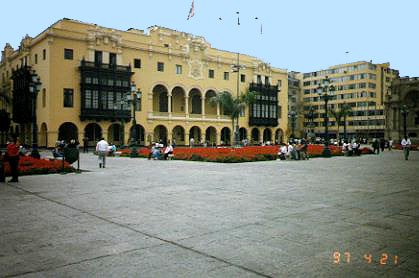This is the page about Lima, the capitol of Peru, called "The City of The Kings"
Lima: city in west central Peru, capital of the country and of
Lima Department, located on the Rímac River between the Pacific Ocean
and Andes Mountains, in Peru's arid coastal region. The country's
largest city.

Climate: It is temperate despite the tropical location, with
temperatures moderated by the cold Peruvian (Humboldt) Current offshore
and fogs (garúa) that blanket the coastal region during the colder
months of May to October.
Landmarks: in downtown Lima include the large Plaza de Armas,
the nearby cathedral (begun 1746), The Presidential Palace, which is guarded
by
The Junin's Husares. Several 16th- and 17th-century
religious structures like San Francisco de Asis Church that survived
a damaging earthquake in 1746.
The Acho Bullring Plaza (1764, restored 1945) is located north of
the Rímac River, in suburban Rímac. The National University of San
Marcos (1551), the National Agrarian University (1902), the
National University of Engineering (1896), and other
major universities are within the metropolitan area. Also of
interest are museums of art, history, archaeology, and philately.
Another interesting colonial building located in downtown, just across San
Francisco de Asis church is "La casa de Pilatos". It is the oldest building in
Lima and it is very well kept. Currently the Tribunal Constitucional operates in this
building. To visit it call previously
for reservations at Casa de Pilatos
Transportation:
Taxis:
In Lima there are everywhere and are affordable. There are not meters
so bargain the fares. For ten soles (about three dollars)
you can go very far.
Combis:
Another way of transportation. Fifty cents of a dollar (one sol and fifty cents)
can take you for example from Cieneguilla to la Perla (Port of
Callao) in Lima.
Moto Taxis:
Another alternative in some suburbs like San Miguel and Cieneguilla.
Airlines:
Continental flies directly to Lima from Houston, Texas, every day.
Other Airlines fly from Miami.
Callao, Peru's chief port, is about 13 km (about 8 mi) to the
west. Other major suburbs include the residential sections of
San Isidro, Monterrico, Jesús María, San Borja, and the famous beach
resorts of Miraflores and Barranco. Huge barriades ("shantytowns"),
also called pueblos jóvenes ("young towns"), have emerged on the
outskirts of the region. Oil drums, cardboard, and other crude
materials house the fast-growing population of impoverished job seekers
from rural Peru who inhabit these towns.
Lima was founded in 1535 by Spanish conquistadores (including
Francisco Pizarro now a controversial figure) and was
originally named Ciudad de los Reyes (City of the Kings). Lima
replaced Cuzco as Spain's viceregal capital of colonial Peru,
and it quickly became Spain's largest and wealthiest settlement in
the New World. Lima became the capital of Peru after the country
became completely independent in 1826. In 1879 during the War of
the Pacific with Chile, Lima was looted and occupied from 1881
to 1883 by Chilean forces. The suburb of Chorrillos was burnt by
Chileans. Rapid industrialization after 1940 was accompanied by a
great increase in the city's population.
Additional Images from Lima and suburbs:
Green Costanera in Miraflores
Parque Las Leyendas (Three Peruvians regions in one place)
Wednesday, March 26, 2025